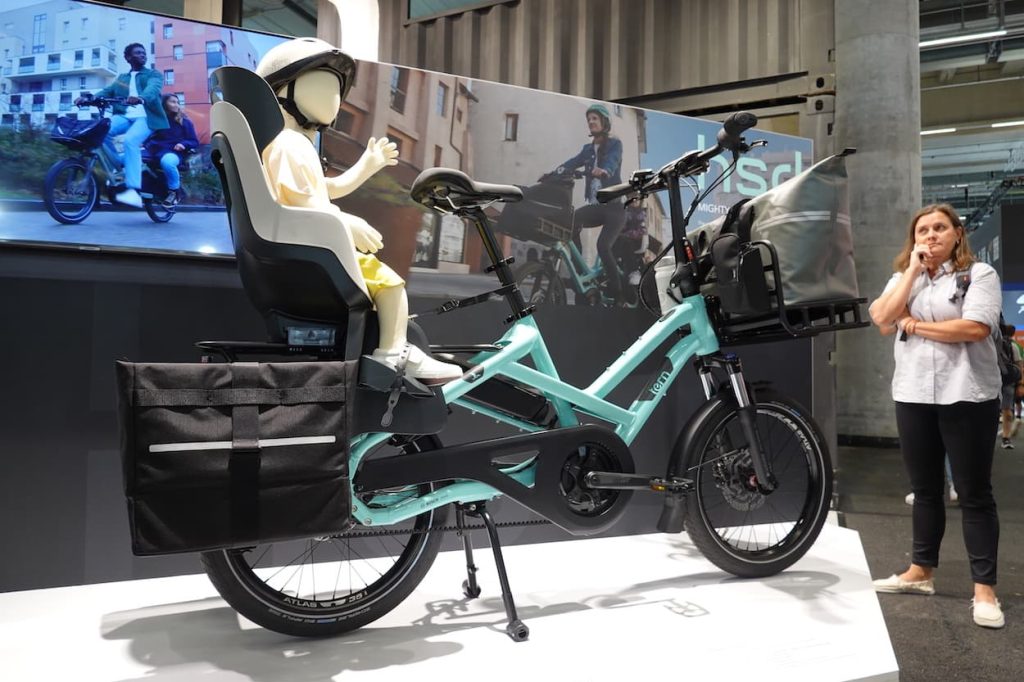Tern recently updated its midtier electric cargo bike, the Tern HSD. I recently had the chance to check out the bike along with Tern’s founder and team captain, Josh Hon, at Eurobike 2023, and here’s what I learned.
First of all, if you aren’t familiar with Tern, then you’re in for a treat.
When it comes to premium electric bicycles that are built specifically for utility jobs, Tern is one of my go-to companies. There are other high-quality e-bikes out there for fitness riding, mountain biking, hardcore commuting, or even just cruising around.
You can spend a pretty penny these days on a high-end e-bike. But for pure utility – such as doing an entire week’s worth of grocery shopping or dropping a couple of kids off at school – Tern has long led the cargo pack. And it’s done so in a package that is barely larger than a typical bike.

I had the chance to test out the first version of the HSD several years ago when it was originally unveiled. It filled an interesting role, bringing many of the advantages of the company’s flagship (and equally flag-expensive) Tern GSD cargo bike. But it did so without a few of the bells and whistles, bringing the price down to a more approachable middle ground that didn’t sting as sharply to the average rider.
Since then, Tern has rolled out a few new models with even more approachable prices, which is why it makes sense that, with the new Tern HSD, the company has focused on heading a bit higher up the market.
With more options available with comfortable price tags, the HSD was able to incorporate several upgrades, chief among them an even more robust design.
One of Tern’s hallmarks isn’t just that their e-bikes are designed for heavy hauling but that they actually go above and beyond to ensure that they are the safest they can be during that heavy hauling. And it goes well past mere UL listing. Tern has used Bosch powertrains for years that come with UL certification. Getting an e-bike UL certified is child’s play compared to what Tern does.
As Tern’s Josh Hon explained to me, they go further than just about any e-bike maker to certify their bikes to extreme loads, such as the 400-pound (181-kilogram) limit of the new Tern HSD.
Most e-bike standards don’t even cover test procedures for weights that high. Several test benches aren’t even capable of physically supporting load testing at that level. And so Tern has largely entered uncharted territory.
They’ve tested their e-bikes up to those extreme load limits to ensure that anyone riding around with two kids on the back will never have to worry if the weight rating on their e-bike is a guesstimate or not – which, unfortunately, it often is. “A lot of manufacturers seem to be saying now, ‘Tern rates its bikes for 400 pounds, so I guess we need to also,’” explained Hon. And yet many of these lower-cost bikes either don’t have certification or they use a certification that stops testing at much lower weight limits.
In fact, many budget bikes that cost a fraction of a Tern HSD (which starts at $4,299) yet are rated to a similar 400 pounds of payload would actually fail at much lower weights – something we’ve seen before. It’s not just how much weight the bike can support but also what happens when a bike carrying two adults hits a pothole.

The Tern HSD includes several hidden touches that help reach that heavyweight rating, especially around the weak points. Creating a basic diamond frame that can support such heavy weight isn’t nearly as hard as ensuring that critical points like the seat tube can also support such heavy loads. Areas like the HSD nameplate behind the seat also serve as hidden gussets that strengthen the frame beyond what a typical bike can handle.
Then there are the non-Tern components. Parts from other OEMs, such as the fork, also have to support those extreme figures. After all, a bike is only as strong as its weakest component. Tern has even helped its suppliers improve the strength of their components to ensure that the HSD would be as rugged as possible. They discovered that their fork supplier wasn’t properly heat-treating the metal in the fork – a process critical for strength – because Tern had required the fork tubes to be extra thick; thus, the oven heating time was no longer sufficient to fully penetrate the metal. As forks kept breaking on the test bench, Tern was able to discover the problem and help the supplier improve its manufacturing to create a stronger component in the end.
This kind of attention to detail – to each and every component that supports a heavy rider or a heavy cargo load – is a testament to what separates the different levels of e-bikes out there. That’s not a dig at budget e-bikes. I ride one every day. But then again, I’m not putting two kids on it, either.

Read the full article here


